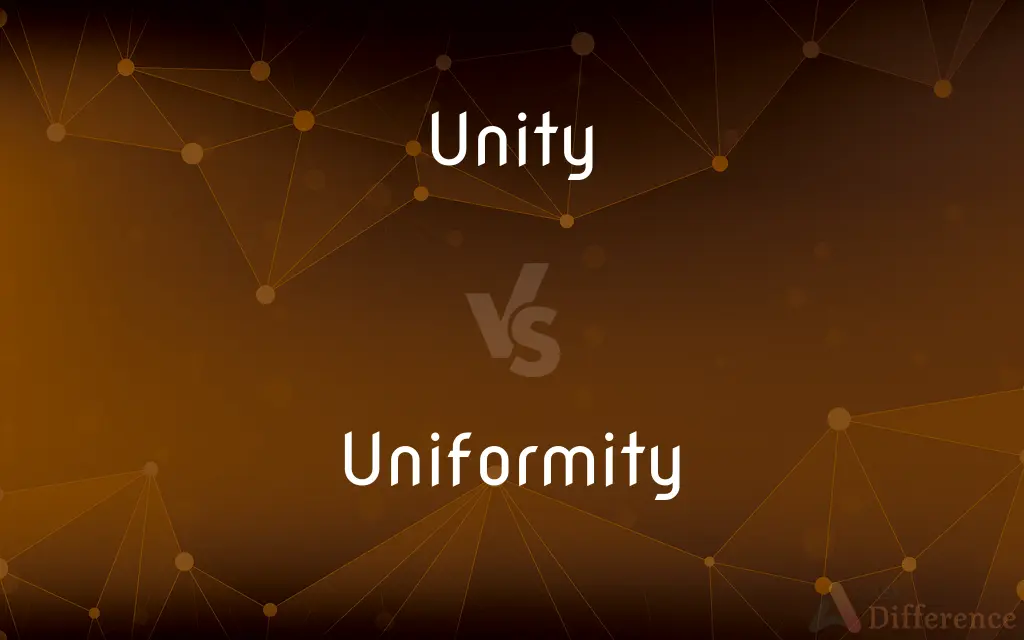Unity vs. Uniformity — What's the Difference?
Edited by Tayyaba Rehman — By Fiza Rafique — Updated on October 27, 2023
Unity refers to being together or at one with someone or something, while Uniformity implies sameness or consistency in form or manner.

Difference Between Unity and Uniformity
Table of Contents
ADVERTISEMENT
Key Differences
Unity and Uniformity are two concepts often used interchangeably but differ in their essential meanings. Unity embodies the idea of togetherness or harmony among different parts or members. It suggests a collective working towards a shared goal, even if the methods or individual characteristics differ. In contrast, Uniformity denotes consistent sameness, either in appearance, method, or approach.
Considering a group of musicians, Unity is their synchronization and harmonious performance, even though each musician plays a different instrument. In the same scenario, Uniformity would be evident if every musician wore the same attire or played the same note. It's the visual or functional consistency that is emphasized.
In the world of design, Unity represents the cohesiveness of different elements to create a harmonious overall look. It might include various shapes, colors, or sizes, but they work together seamlessly. On the other hand, Uniformity in design would mean using repetitive patterns, colors, or shapes throughout, creating a consistent visual theme.
While both terms can be applied in various contexts, their differentiation is essential. Unity celebrates diversity and collective strength, emphasizing collaboration and harmony. In contrast, Uniformity focuses on replicating the same aspects, ensuring there's minimal deviation in the process or appearance.
Comparison Chart
Definition
Harmony among diverse elements
Consistency in form or manner
ADVERTISEMENT
Emphasis
Togetherness and collaboration
Sameness or repetition
In Groups
Individuals working harmoniously towards a shared goal
All members appearing or behaving in the same way
In Design
Cohesiveness of different elements
Using repetitive patterns or colors
In Context
Celebrates diversity and collective strength
Ensures minimal deviation in process or appearance
Compare with Definitions
Unity
An undivided or unbroken completeness.
The novel's plot had a clear sense of unity from start to finish.
Uniformity
The quality of being the same in various aspects.
The uniformity of the soldiers' attire was striking.
Unity
The state of being united or joined as a whole.
The unity of the team led to their victory.
Uniformity
Evenness or regularity in appearance or design.
The uniformity of the tiles made the room look larger.
Unity
Harmony in a group or set of entities.
The unity of the choir was evident in their performance.
Uniformity
Always the same, as in character or degree; unvarying
Planks of uniform length.
Unity
The state or quality of being one or united into a whole
"The Founding Fathers had abhorred the concept of parties, fearing that they would undermine the unity of the nation through factionalism" (Julian E. Zelizer).
Uniformity
Being the same as or consonant with another or others
Rows of uniform brick houses.
Unity
The state or quality of being in accord; harmony
The judges ruled in unity on the matter.
Uniformity
A distinctive set of clothing intended to identify the members of a specific group
A police uniform.
Unity
The state or quality of being unified in an aesthetic whole, as in a work of literature
The novel's thematic unity.
Uniformity
To make (something) uniform.
Unity
A whole that is a combination of parts
A group of ideas that taken together constitute a unity.
Uniformity
To provide or dress with a uniform.
Unity
Singleness or constancy of purpose or action; continuity
"In an army you need unity of purpose" (Emmeline Pankhurst).
Uniformity
The state of being uniform, alike and lacking variety.
The uniformity of the decor
Unity
One of the three principles of dramatic structure derived by French neoclassicists from Aristotle's Poetics, stating that a drama should have but one plot, which should take place in a single day and be confined to a single locale.
Uniformity
The absence of alternatives or diversity; sameness.
Unity
The number 1.
Uniformity
A collection of identical things
A uniformity is a kind of plurality
Unity
See identity element.
Uniformity
The quality or state of being uniform; freedom from variation or difference; resemblance to itself at all times; sameness of action, effect, etc., under like conditions; even tenor; as, the uniformity of design in a poem; the uniformity of nature.
Unity
(uncountable) Oneness; the state or fact of being one undivided entity.
Uniformity
Consistency; sameness; as, the uniformity of a man's opinions.
Unity
Agreement; harmony.
Uniformity
Similitude between the parts of a whole; as, the uniformity of sides in a regular figure; beauty is said to consist in uniformity with variety.
Unity
A single undivided thing, seen as complete in itself.
Uniformity
Continued or unvaried sameness or likeness.
Unity
(drama) Any of the three classical rules of drama: unity of action (nothing should be admitted not directly relevant to the development of the plot), unity of place (the scenes should be set in the same place), and unity of time (all the events should be such as might happen within a single day).
Uniformity
Conformity to a pattern or rule; resemblance, consonance, or agreement; as, the uniformity of different churches in ceremonies or rites.
Unity
(mathematics) The number 1 or any element of a set or field that behaves under a given operation as the number 1 behaves under multiplication.
The cube roots of unity
Uniformity
A condition in which everything is regular and unvarying
Unity
(legal) The peculiar characteristics of an estate held by several in joint tenancy.
Uniformity
The quality of lacking diversity or variation (even to the point of boredom)
Unity
(Quakerism) The form of consensus in a Quaker meeting for business which signals that a decision has been reached. In order to achieve unity, everyone who does not agree with the decision must explicitly stand aside, possibly being recorded in the minutes as doing so.
Uniformity
Consistency in form, manner, or character.
The factory prized uniformity in its products.
Unity
The state of being one; oneness.
Whatever we can consider as one thing suggests to the understanding the idea of unity.
Uniformity
Lack of variation or diversity.
Critics felt the artist's works lacked depth due to their uniformity.
Unity
Concord; harmony; conjunction; agreement; uniformity; as, a unity of proofs; unity of doctrine.
Behold, how good and how pleasant it is for brethren to dwell together in unity!
Uniformity
The state of being undifferentiated or identical.
The test results showed a surprising uniformity across all samples.
Unity
Any definite quantity, or aggregate of quantities or magnitudes taken as one, or for which 1 is made to stand in calculation; thus, in a table of natural sines, the radius of the circle is regarded as unity.
Unity
In dramatic composition, one of the principles by which a uniform tenor of story and propriety of representation are preserved; conformity in a composition to these; in oratory, discourse, etc., the due subordination and reference of every part to the development of the leading idea or the eastablishment of the main proposition.
Unity
Such a combination of parts as to constitute a whole, or a kind of symmetry of style and character.
Unity
The peculiar characteristics of an estate held by several in joint tenancy.
Unity
An unreduced or unbroken completeness or totality
Unity
The smallest whole number or a numeral representing this number;
He has the one but will need a two and three to go with it
They had lunch at one
Unity
The quality of being united into one
Unity
A singular undivided whole.
The sculpture was carved from a unity of marble.
Unity
The state of being in accord or agreement.
The treaty symbolized the unity of the two nations.
Common Curiosities
How is Uniformity defined?
Uniformity implies sameness or consistency in form or manner.
Does Uniformity require everything to be identical?
Yes, Uniformity emphasizes consistency and identical characteristics.
What does Unity refer to?
Unity refers to being together or at one with someone or something.
Does Unity mean sameness?
No, Unity emphasizes harmony and togetherness, not necessarily sameness.
Is Unity about collective strength?
Yes, Unity often emphasizes the strength that comes from collaboration and togetherness.
Can a diverse group have Unity?
Yes, a diverse group can exhibit Unity by working harmoniously towards a shared goal.
Can Unity exist without Uniformity?
Absolutely, Unity can exist in the presence of diversity, without the need for Uniformity.
Can a design have both Unity and Uniformity?
Yes, a design can have varied elements working cohesively (Unity) while also having repetitive patterns (Uniformity).
In which contexts is Uniformity most evident?
Uniformity is most evident in scenarios that require consistency, like manufacturing or military attire.
Which term celebrates diversity?
Unity celebrates diversity and collective strength.
Is Uniformity about repetition?
Yes, Uniformity often involves repetition and consistent sameness.
Can there be Uniformity in a diverse group?
While diversity might seem contrary to Uniformity, a diverse group can exhibit Uniformity in certain behaviors, objectives, or appearances.
How does Unity manifest in a team?
In a team, Unity manifests as collaboration, shared goals, and harmonious interactions.
How can one identify Uniformity in design?
Uniformity in design is identified by repetitive patterns, colors, or shapes throughout.
Is Uniformity always rigid?
While often associated with rigidity, Uniformity can also imply a harmonious consistency.
Share Your Discovery

Previous Comparison
Reseller vs. Retailer
Next Comparison
Blog vs. ArticleAuthor Spotlight
Written by
Fiza RafiqueFiza Rafique is a skilled content writer at AskDifference.com, where she meticulously refines and enhances written pieces. Drawing from her vast editorial expertise, Fiza ensures clarity, accuracy, and precision in every article. Passionate about language, she continually seeks to elevate the quality of content for readers worldwide.
Edited by
Tayyaba RehmanTayyaba Rehman is a distinguished writer, currently serving as a primary contributor to askdifference.com. As a researcher in semantics and etymology, Tayyaba's passion for the complexity of languages and their distinctions has found a perfect home on the platform. Tayyaba delves into the intricacies of language, distinguishing between commonly confused words and phrases, thereby providing clarity for readers worldwide.
















































